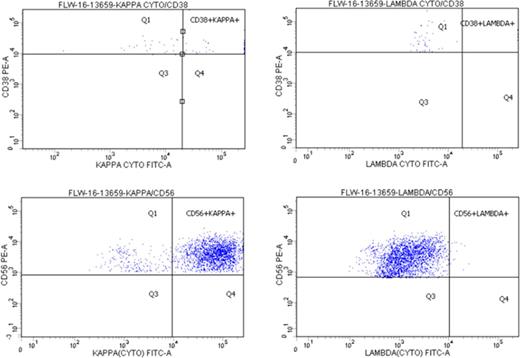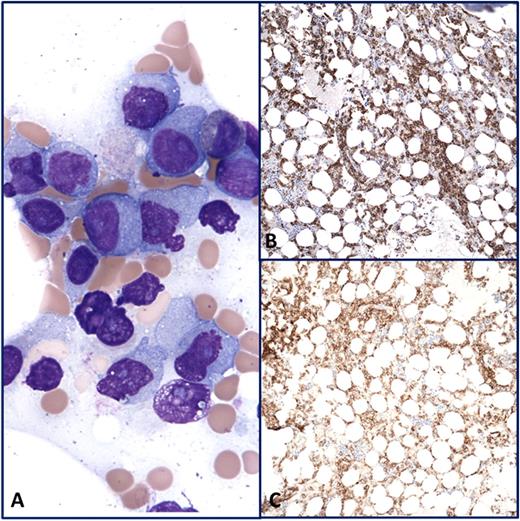Abstract
The diagnosis of multiple myeloma (MM) requires the demonstration of clonal plasma cells at ≥10% marrow cellularity or a biopsy-proven bony or extra-medullary plasmacytoma, plus one or more myeloma-defining events. Clinical laboratories use multi-parameter flow cytometry (MFC) evaluation of cytoplasmic light chain expression in CD38-bright, CD45-dim or CD138-positive, CD45dim cells to establish plasma cell clonality with a high-degree of sensitivity and specificity.
Daratumumab, a humanized IgG1 kappa monoclonal antibody targeting CD38, has been shown to significantly improve outcomes in refractory MM, and daratumumab was granted breakthrough status in 2013. Daratumumab is currently approved for treatment of MM patients who have failed first-line therapies. It has been noted that daratumumab can interfere in blood bank assays for antibody screening, as well as serum protein electrophoresis (SPEP). We describe for the first time daratumumab interference in the assessment of plasma cell neoplasms by MFC; daratumumab interfered with both CD38- and CD138-based gating strategies in three MM patients.
Patient A is a 68 year old man with a 10 year history of MM who had failed multiple therapies. He had then been treated with daratumumab for two months, stopping therapy 25 days prior to bone marrow assessment. Patient B is a 53 year old man with a 3 year history MM who had failed numerous treatments. He had been receiving daratumumab monotherapy for two months at the time of his bone marrow studies. On multiple marrow aspirates at times of relapse prior to receiving daratumumab, both patients had demonstrated CD38-bright positive CD45dim/negative plasma cells expressing aberrant CD56, as well as kappa light chain restriction; mature B cells were polyclonal in both. Patient C is a 65 year old man with a four-year history of MM status post autologous stem cell transplantation, who had been receiving carfilzomib and pomalidomide following relapse and continues to have rising lambda light chains and rib pain. He now has abnormal plasma cells in blood worrisome for plasma cell leukemia.
Bone marrow aspirates from patients A and B, and blood from patient C demonstrated near absence of CD38-bright events as detected by MFC (Figure 1). Hypothesizing that these results were due to blocking of the CD38 antigen by daratumumab, gating on CD138-positive events was assessed; surprisingly, virtually no CD138-positive events were detected by MFC. All 3 samples demonstrated a CD56-positive CD45dim population; when light chain studies were employed using specific gating on the CD56-positive population, light chain restriction was demonstrated in all patients (Figure 1). Aspirate morphology confirmed numerous abnormal, nucleolated plasma cells (Figure 2A), thus excluding a sampling error. CD138 and CD38 expression was also tested on the marrow biopsy cores from both patients. In contrast to MFC, immunohistochemistry (IHC) showed positive labeling of plasma cells with both CD138 (Figure 2B) and CD38 (Figure 2C). The reason for the labeling discrepancy between MFC and IHC is unknown. The different antibodies in the assays may target different epitopes; alternatively, tissue fixation/decalcification may dissociate the anti-CD38 therapeutic monoclonal from its target.
Detection of clonal plasma cell populations is important for assessing response to therapy. Laboratories relying primarily on MFC to assess marrow aspirates without a concomitant biopsy may falsely diagnose remission or significant disease amelioration in daratumumab-treated patients. MFC is generally highly sensitive for monitoring minimal residual disease (MRD) in MM, but daratumumab-treated patients should have their biopsy evaluated to confirm the MRD assessment by MFC. We were able to detect large numbers of plasma cells and also demonstrate clonality in our patients based on an alternative MFC marker, aberrant CD56 expression, an approach that may not be possible in all cases.
Flow cytometry showing near-absence of CD38-bright elements in the marrow of patient A (top panels). Gating on CD56-positive cells in the same sample reveals a kappa light chain-restricted plasma cell population (bottom panels).
Flow cytometry showing near-absence of CD38-bright elements in the marrow of patient A (top panels). Gating on CD56-positive cells in the same sample reveals a kappa light chain-restricted plasma cell population (bottom panels).
The marrow aspirate from Fig. 1 shows abnormal plasma cells (A). Immunohistochemistry on the concomitant biopsy shows the presence of numerous CD138-positive (B) and CD38-positive (C) plasma cells.
The marrow aspirate from Fig. 1 shows abnormal plasma cells (A). Immunohistochemistry on the concomitant biopsy shows the presence of numerous CD138-positive (B) and CD38-positive (C) plasma cells.
No relevant conflicts of interest to declare.
Author notes
Asterisk with author names denotes non-ASH members.



This feature is available to Subscribers Only
Sign In or Create an Account Close Modal